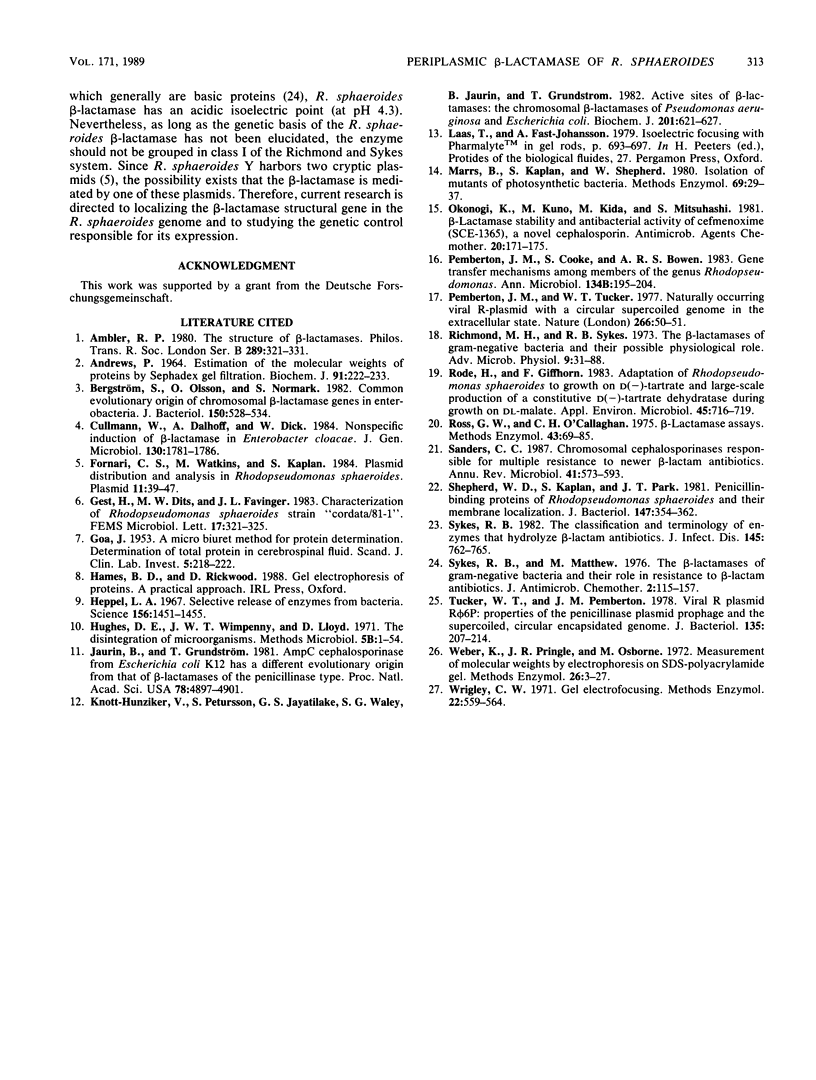Abstract
Thirteen strains of the gram-negative, facultative phototrophic bacterium Rhodobacter sphaeroides were examined fro susceptibility to beta-lactam antibiotics. All strains were sensitive to the semisynthetic penicillins ampicillin, carbenicillin, oxacillin, cloxacillin, and methicillin, but 10 of the 13 strains were resistant to penicillin G, as well as a number of cephalosporins, such as cephalothin, cephapirin, and cephalosporin C. A beta-lactamase (EC 3.5.2.6) with strong cephalosporinase activity was detected in all of the resistant strains of R. sphaeroides. With strain Y-1 as a model, it was shown that the beta-lactamase was inducible by penicillin G, cephalosporin C, cephalothin, and to some minor extent, cephapirin. The beta-lactamase was located in the periplasmic space, from which it could be extracted by osmotic shock disruption. By using this fraction, the beta-lactamase was purified 34-fold to homogeneity by steps involving batch adsorption to and elution from DEAE-Sephadex A50, chromatography on Q-Sepharose, and preparative polyacrylamide gel electrophoresis. The molecular masses of the native and denatured enzymes were determined to be 38.5 kilodaltons by gel filtration and 40.5 kilodaltons by sodium dodecyl sulfate-polyacrylamide gel electrophoresis, respectively, indicating a monomeric structure. The isoelectric point was estimated to be at pH 4.3. In Tris hydrochloride buffer, optimum enzyme activity was measured at pH 8.5. The beta-lactamase showed high activity in the presence of the substrates cephalothin, cephapirin, cephalosporin C, and penicillin G, for which the apparent Km values were 144, 100, 65, and 110 microM, respectively. Cephalexin, cepharidine, and cephaloridine were poor substrates. The beta-lactamase was strongly inhibited by cloxacillin and oxacillin but only slightly inhibited by phenylmethylsulfonyl fluoride or thiol reagents such as iodoacetate and p-chloromercuribenzoate.
Full text
PDF





Images in this article
Selected References
These references are in PubMed. This may not be the complete list of references from this article.
- Ambler R. P. The structure of beta-lactamases. Philos Trans R Soc Lond B Biol Sci. 1980 May 16;289(1036):321–331. doi: 10.1098/rstb.1980.0049. [DOI] [PubMed] [Google Scholar]
- Andrews P. Estimation of the molecular weights of proteins by Sephadex gel-filtration. Biochem J. 1964 May;91(2):222–233. doi: 10.1042/bj0910222. [DOI] [PMC free article] [PubMed] [Google Scholar]
- Bergström S., Olsson O., Normark S. Common evolutionary origin of chromosomal beta-lactamase genes in enterobacteria. J Bacteriol. 1982 May;150(2):528–534. doi: 10.1128/jb.150.2.528-534.1982. [DOI] [PMC free article] [PubMed] [Google Scholar]
- Cullmann W., Dalhoff A., Dick W. Nonspecific induction of beta-lactamase in Enterobacter cloacae. J Gen Microbiol. 1984 Jul;130(7):1781–1786. doi: 10.1099/00221287-130-7-1781. [DOI] [PubMed] [Google Scholar]
- Fornari C. S., Watkins M., Kaplan S. Plasmid distribution and analyses in Rhodopseudomonas sphaeroides. Plasmid. 1984 Jan;11(1):39–47. doi: 10.1016/0147-619x(84)90005-2. [DOI] [PubMed] [Google Scholar]
- GOA J. A micro biuret method for protein determination; determination of total protein in cerebrospinal fluid. Scand J Clin Lab Invest. 1953;5(3):218–222. doi: 10.3109/00365515309094189. [DOI] [PubMed] [Google Scholar]
- Heppel L. A. Selective release of enzymes from bacteria. Science. 1967 Jun 16;156(3781):1451–1455. doi: 10.1126/science.156.3781.1451. [DOI] [PubMed] [Google Scholar]
- Jaurin B., Grundström T. ampC cephalosporinase of Escherichia coli K-12 has a different evolutionary origin from that of beta-lactamases of the penicillinase type. Proc Natl Acad Sci U S A. 1981 Aug;78(8):4897–4901. doi: 10.1073/pnas.78.8.4897. [DOI] [PMC free article] [PubMed] [Google Scholar]
- Knott-Hunziker V., Petursson S., Jayatilake G. S., Waley S. G., Jaurin B., Grundström T. Active sites of beta-lactamases. The chromosomal beta-lactamases of Pseudomonas aeruginosa and Escherichia coli. Biochem J. 1982 Mar 1;201(3):621–627. doi: 10.1042/bj2010621. [DOI] [PMC free article] [PubMed] [Google Scholar]
- Okonogi K., Kuno M., Kida M., Mitsuhashi S. Beta-lactamase stability and antibacterial activity of cefmenoxime (SCE-1365), a novel cephalosporin. Antimicrob Agents Chemother. 1981 Aug;20(2):171–175. doi: 10.1128/aac.20.2.171. [DOI] [PMC free article] [PubMed] [Google Scholar]
- Pemberton J. M., Cooke S., Bowen A. R. Gene transfer mechanisms among members of the genus Rhodopseudomonas. Ann Microbiol (Paris) 1983 Jul-Aug;134B(1):195–204. doi: 10.1016/s0769-2609(83)80105-7. [DOI] [PubMed] [Google Scholar]
- Pemberton J. M., Tucker W. T. Naturally occurring viral R plasmid with a circular supercoiled genome in the extracellular state. Nature. 1977 Mar 3;266(5597):50–51. doi: 10.1038/266050a0. [DOI] [PubMed] [Google Scholar]
- Richmond M. H., Sykes R. B. The beta-lactamases of gram-negative bacteria and their possible physiological role. Adv Microb Physiol. 1973;9:31–88. doi: 10.1016/s0065-2911(08)60376-8. [DOI] [PubMed] [Google Scholar]
- Rode H., Giffhorn F. Adaptation of Rhodopseudomonas sphaeroides to Growth on d-(-)-Tartrate and Large-Scale Production of a Constitutive d-(-)-Tartrate Dehydratase During Growth on dl-Malate. Appl Environ Microbiol. 1983 Feb;45(2):716–719. doi: 10.1128/aem.45.2.716-719.1983. [DOI] [PMC free article] [PubMed] [Google Scholar]
- Ross G. W., O'Callaghan C. H. Beta-lactamase assays. Methods Enzymol. 1975;43:69–85. doi: 10.1016/0076-6879(75)43081-6. [DOI] [PubMed] [Google Scholar]
- Sanders C. C. Chromosomal cephalosporinases responsible for multiple resistance to newer beta-lactam antibiotics. Annu Rev Microbiol. 1987;41:573–593. doi: 10.1146/annurev.mi.41.100187.003041. [DOI] [PubMed] [Google Scholar]
- Shepherd W. D., Kaplan S., Park J. T. Penicillin-binding proteins of Rhodopseudomonas sphaeroides and their membrane localization. J Bacteriol. 1981 Aug;147(2):354–361. doi: 10.1128/jb.147.2.354-361.1981. [DOI] [PMC free article] [PubMed] [Google Scholar]
- Sykes R. B., Matthew M. The beta-lactamases of gram-negative bacteria and their role in resistance to beta-lactam antibiotics. J Antimicrob Chemother. 1976 Jun;2(2):115–157. doi: 10.1093/jac/2.2.115. [DOI] [PubMed] [Google Scholar]
- Sykes R. B. The classification and terminology of enzymes that hydrolyze beta-lactam antibiotics. J Infect Dis. 1982 May;145(5):762–765. doi: 10.1093/infdis/145.2.762. [DOI] [PubMed] [Google Scholar]
- Tucker W. T., Pemberton J. M. Viral R plasmid Rphi6P: properties of the penicillinase plasmid prophage and the supercoiled, circular encapsidated genome. J Bacteriol. 1978 Jul;135(1):207–214. doi: 10.1128/jb.135.1.207-214.1978. [DOI] [PMC free article] [PubMed] [Google Scholar]
- Weber K., Pringle J. R., Osborn M. Measurement of molecular weights by electrophoresis on SDS-acrylamide gel. Methods Enzymol. 1972;26:3–27. doi: 10.1016/s0076-6879(72)26003-7. [DOI] [PubMed] [Google Scholar]



